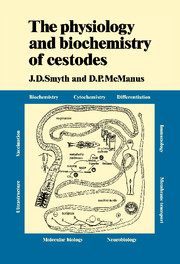Book contents
- Frontmatter
- Contents
- Preface
- Acknowledgements
- 1 The cestodes: general considerations
- 2 The adult cestode: special structural features relevant to its physiology
- 3 The adult cestode in its environment
- 4 The adult: general metabolism and chemical composition; lipid metabolism
- 5 The adult: carbohydrate metabolism
- 6 The adult: proteins and nucleic acids
- 7 The biology of the egg
- 8 Developmental biology of larvae
- 9 Development within definitive host
- 10 Cultivation of cestodes in vitro
- 11 Immunobiology of cestodes
- References
- Index
11 - Immunobiology of cestodes
Published online by Cambridge University Press: 24 November 2009
- Frontmatter
- Contents
- Preface
- Acknowledgements
- 1 The cestodes: general considerations
- 2 The adult cestode: special structural features relevant to its physiology
- 3 The adult cestode in its environment
- 4 The adult: general metabolism and chemical composition; lipid metabolism
- 5 The adult: carbohydrate metabolism
- 6 The adult: proteins and nucleic acids
- 7 The biology of the egg
- 8 Developmental biology of larvae
- 9 Development within definitive host
- 10 Cultivation of cestodes in vitro
- 11 Immunobiology of cestodes
- References
- Index
Summary
General considerations
Host-parasite interaction
GENERAL COMMENTS
With rare exceptions (e.g. Hymenolepis nana) a cestode makes contact with the tissues of at least two different hosts during its life cycle. The degree of immunological response by each host is related to three main factors: (a) the nature of the tissue site invaded, (b) the intimacy of the host'parasite contact, and (c) the stage of development of the cestode, i.e. whether adult or larva. For example, in the case of Taenia saginata, the host'parasite contacts established during the life cycle are: (a) the scolex, when attached to the intestine of the definitive (human) host, (b) the oncosphere, during its penetration of the intestinal mucosa of the intermediate (bovine) host and subsequent migration, and finally (c) the developing larva established in its final tissue site.
This chapter will deal with the immune reactions of the host to adult and larval cestodes. Most work has been centred on species of Taenia and Echinococcus in man and domestic animals and on the Hymenolepididae in laboratory animals. In parallel with the remarkable developments in recombinant DNA technology (see Chapter 6) which holds out the tantalising possibilities of producing parasite vaccines – there has been an explosive interest in attempts to develop vaccines against cestodes of medical, veterinary or economic importance, so far without significant success (p. 301).
- Type
- Chapter
- Information
- The Physiology and Biochemistry of Cestodes , pp. 283 - 304Publisher: Cambridge University PressPrint publication year: 1989
- 1
- Cited by



